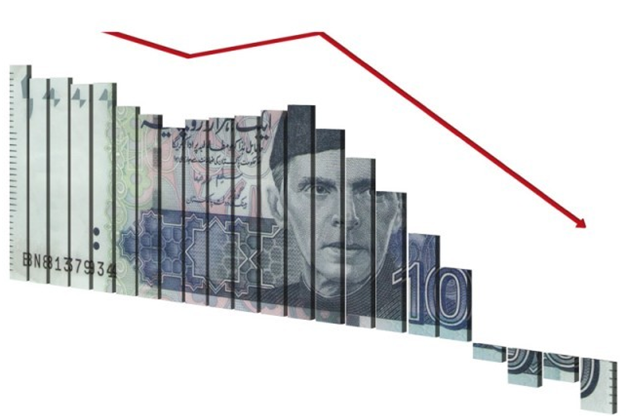–Economy to shrink the most in decades while fiscal deficit likely to widen to 9.4pc of GDP in FY20
–Agriculture sector grows 2.67pc, whereas industrial and services sectors shrink -2.64pc and -3.4pc, respectively
ISLAMABAD: Pakistan’s economy will shrink the most in decades while its fiscal deficit will likely widen to 9.4pc of gross domestic product by the end of the FY20, according to the Pakistan Economic Survey 2019-20.
“The country’s provisional gross domestic product (GDP) growth rate for FY20 will likely contract 0.4pc instead of growing 3.3pc as previously forecast,” Adviser to PM on Finance Abdul Hafeez Shaikh told a news conference while unveiling the budget on Thursday.
This contraction would be the deepest in decades.
“The economic contraction depicts the challenges that the Pakistan Tehreek-e-Insaf (PTI) government faced in its second year in power and the miseries caused by the Covid-19 that started battering the world in December 2019.”
The IMF and World Bank had earlier projected that the economy will shrink by up to 2.6pc.
The adviser said the IMF and World Bank were making bleaker assumptions keeping in view the severity and duration of the coronavirus pandemic. “In my view, we will have a better estimation when this year ends on June 30.”
He highlighted the government’s swift and decisive policy actions since the start of the current fiscal year, including resource mobilisation, completion of the International Monetary Fund (IMF) programme, austerity measures, and monetary policies helping stabilise the economy.
The adviser stated that these measures helped the economy to reverse large external and internal imbalances. He said that significant improvement in external accounts was made as the current account and trade deficit witnessed a substantial contraction.
“Foreign reserves steadily improved. There was an increase in foreign direct investment (FDI). The credit rating profile also improved. Fiscal performance remained strong during the first three quarters of the outgoing fiscal year, on the back of consolidation efforts and targeted reforms.”
The adviser said the Covid-19 has pushed the global economies towards a recession. Pakistan has also been affected by the unprecedented health and economic shocks caused by the outbreak of coronavirus. During the current fiscal year, Pakistan’s economy has undergone a sharp contraction as growth is recorded at negative 0.4pc.
“To mitigate the socio-economic impact of the pandemic, the government announced a stimulus package of Rs1.24 trillion, and offered further relief measures through the State Bank of Pakistan. The policy rate was also cut by 5.25pc to 8.0pc,” he said. “The monetary and fiscal policy interventions have been made to restore the economic activity in this difficult time and to reduce negative effects on poverty and unemployment.”
The agriculture sector recorded a growth of 2.67pc against the target of 3.5pc, however, the industrial and services sectors witnessed negative growth rates of -2.64pc and -3.4pc, respectively, pulling the overall growth rate down, the adviser stated.
Sheikh said manufacturing contracted by 22.9pc year-on-year in March 2020 but added that “fiscal deficit was still manageable from July-March 2020 at 4pc of the GDP while last year it was 5.1pc of the GDP” in the same period.
“The government has taken loans to tackle the burden of the debt left by previous governments,” said Shaikh. “Pakistan returned Rs5,000 billion in debt – the loans of past years.”
“Tax collection target for FY20 was ambitious and the government doesn’t want to collect it aggressively in a Covid hit economy. When the economy recovers, we hope tax collection will rise due to economic recovery.”
Shaikh said the PTI government did not green-light any additional grants for any government department for a year. “We have entered the area of primary surplus. We controlled government expenditure. Our primary expenditure was less than our revenue which may be a first in the country’s history.”
The finance adviser reiterated that PM Imran’s vision was that every decision benefits the general public. “A large amount was allocated to benefit the lower class. Rs152 billlion were set aside for the merged areas.”
For the upcoming fiscal year, the government has approved a low-economic growth plan, suggesting that the country will not be out of economic wounds in the next fiscal year too. The following graphs highlight the economic trajectory of key indicators in the preceding fiscal years.
—
Team Profit at Pakistan Today




